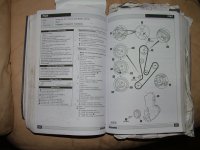Whiskers
New member
Hello everyone! Firstly, Happy New year to one and all on the forum.
Now recently I had some time to finish the work on my van. It's a 2014 Fiat Ducato Maxi with the 2.3L MultiJet engine. Same as the Iveco.
When I order parts for my vehicles, I try not to get the cheapest parts, but not always the most expensive parts either and I try and stick to manufacturers that I know. This was also the case now when I did the timing belt (SKF) and a new waterpump (Valeo).
After a lot of cleaning and prep work I started the installation. As I'm sure many of you know, the high pressure fuel pump bolts on to the waterpump housing with three bolts. I secured the high pressure fuel pump with the original bolts to the new Valeo waterpump, but when it came to installing the pulley for the high pressure fuel pump I noticed the pulley makes contact with the fuel pump bolts and this is by hand without me even having the nut on that secures the pulley. I thought that perhaps the fuel pump was not sitting flush with the rear of the waterpump housing but it was and I tripple checked it. Can it be that the thickness of the Valeo waterpump housing is different to the old waterpump hence the pulley making contact? I replaced the bolts with other bolts with a slightly thinner head and could secure the pully. There is clearance between the pulley and the bolts, and the pully and the waterpump housing, but really not much! This worries me a bit as the timing belt runs on the fuel pump pulley and I know these are interference engines.
Also what I think I should mention, is that the new bolts I used are A2 Stainless Steel bolts. Are they too hard and at risk of snapping off for example? I think the original bolts are a milder steel that has the ability to stretch a bit more. I don't know to be honest, hence me asking.
So I assembled everything and the van started up beautifully and purrs like a kitten, but I am still worried about this that I have mentioned above.
One more quick question... The SKF timing belt tensioner has got two little triangles on it. Am I right in assuming those triangles need to allign point to point when tensioning the timing belt? After tensioning the belt I could still bend it over a bit by hand which as far as I know is correct. I couldn't find any info regarding this, but there is quite a lot of info on the net regarding the Gates timing belt kits, but not this that I have.
That is all for now. I am looking forward to the light that some of you may shed on this matter for me.
Regards, Whiskers
Now recently I had some time to finish the work on my van. It's a 2014 Fiat Ducato Maxi with the 2.3L MultiJet engine. Same as the Iveco.
When I order parts for my vehicles, I try not to get the cheapest parts, but not always the most expensive parts either and I try and stick to manufacturers that I know. This was also the case now when I did the timing belt (SKF) and a new waterpump (Valeo).
After a lot of cleaning and prep work I started the installation. As I'm sure many of you know, the high pressure fuel pump bolts on to the waterpump housing with three bolts. I secured the high pressure fuel pump with the original bolts to the new Valeo waterpump, but when it came to installing the pulley for the high pressure fuel pump I noticed the pulley makes contact with the fuel pump bolts and this is by hand without me even having the nut on that secures the pulley. I thought that perhaps the fuel pump was not sitting flush with the rear of the waterpump housing but it was and I tripple checked it. Can it be that the thickness of the Valeo waterpump housing is different to the old waterpump hence the pulley making contact? I replaced the bolts with other bolts with a slightly thinner head and could secure the pully. There is clearance between the pulley and the bolts, and the pully and the waterpump housing, but really not much! This worries me a bit as the timing belt runs on the fuel pump pulley and I know these are interference engines.
Also what I think I should mention, is that the new bolts I used are A2 Stainless Steel bolts. Are they too hard and at risk of snapping off for example? I think the original bolts are a milder steel that has the ability to stretch a bit more. I don't know to be honest, hence me asking.
So I assembled everything and the van started up beautifully and purrs like a kitten, but I am still worried about this that I have mentioned above.
One more quick question... The SKF timing belt tensioner has got two little triangles on it. Am I right in assuming those triangles need to allign point to point when tensioning the timing belt? After tensioning the belt I could still bend it over a bit by hand which as far as I know is correct. I couldn't find any info regarding this, but there is quite a lot of info on the net regarding the Gates timing belt kits, but not this that I have.
That is all for now. I am looking forward to the light that some of you may shed on this matter for me.
Regards, Whiskers




